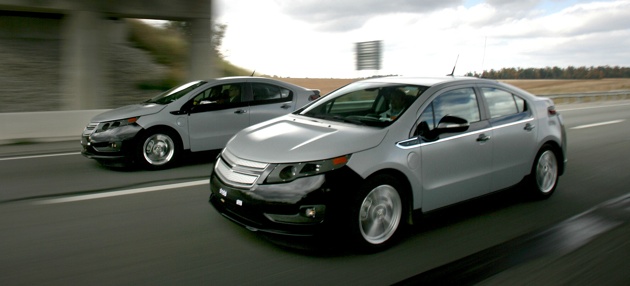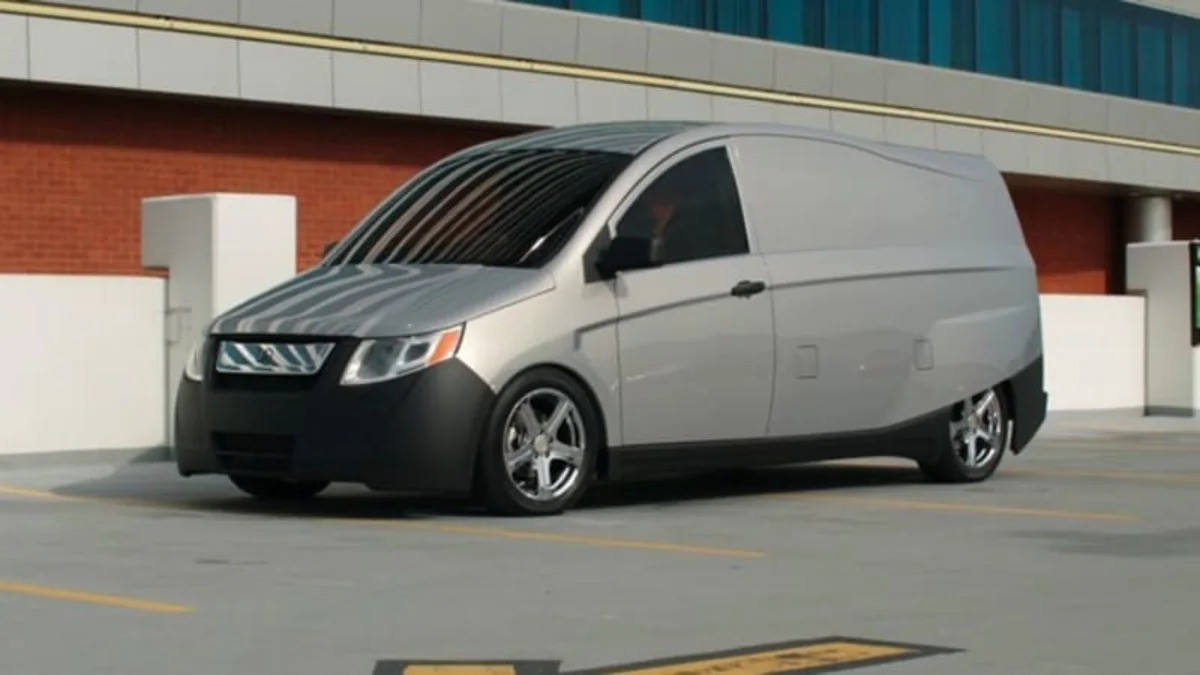Bright IDEA PHEV at the Business of Plugging In conference - Click above for high-res image gallery
 EV business may be booming soon
EV business may be booming soon
I dropped by the Center for Automotive Research's (CAR) "The Business of Plugging In" conference in Detroit recently and came away with a collection of quotes and useful information from movers and shakers working to make vehicle electrification happen.
Most reasonable observers understand that electric vehicles will not replace liquid-fueled vehicles in large numbers any time soon due to their three key disadvantages of high battery cost, limited driving range and long recharge times. But everyone sees that they will become an increasingly viable alternative as automakers respond to growing consumer demand and ever-toughening fuel economy standards.
Respected research firm J.D. Power and Associates forecasts that, while 90 percent of U.S. light vehicles sales today are gasoline-powered (most of the other 10 percent are flex-fuels and diesels), the gas-only share will decline to about 80 percent in 2012 and less than 75 percent by 2016. Part of the alternative-energy 25 percent will be 1.5 million gas-electric hybrids (about nine percent of projected total sales), including plug-ins.
Power's good-news predictions: the number of hybrid models available in the U.S. will increase from 22 today to more than 100 by 2015, and the number of "pure" (battery only) EV models will swell from one (the Tesla roadster) to at least 13 by 2012. Bad news for pure EV fans: Power says just 0.5 percent of sales (fewer than 100K units) will be pure EVs by 2015. There's more after the jump.
Still, the opportunities for electric vehicle component suppliers will be huge. As will the challenges. One topic of discussion was that parts suppliers for electric-powered vehicles, many of them small specialty electronics builders, will have to substantially improve to meet very stringent auto industry quality and reliability requirements.
For example, an annual cell failure rate of one in 200,000 for li-ion batteries used in consumer electronics products that use only one cell may be acceptable, said Ricardo, Inc. global vice president Karina Morley. But that same cell failure rate translates to one in 2,000 for vehicle-size packs of 100 or more Li-ion cells – completely unacceptable. Achieving an acceptable cell failure rate of less than one in a million, Morley said, will require extremely good manufacturing process control and sophisticated battery management to carefully balance cell-to-cell voltage, energy and temperature.
On a more positive note, the country's electric utilities as a group pledged to "move forward aggressively to create the infrastructure to support the full-scale commercialization and deployment of plug-in electric vehicles (PEVs)." Anthony F. Early, Jr., chairman of the Edison Electric Institute and Chairman and CEO of DTE Energy, said, "Our industry acutely recognizes that now is the time to redouble our ongoing efforts to lay the groundwork for making plug-in electric transportation in this country a reality, not just a vision. We, as an industry, are eager to collaborate with the auto industry and others to bring PEVs to market."
Five key elements of this industry-wide pledge are:
- Infrastructure – working with state and local governments on system impacts and potential problems with fueling large numbers of plug-in vehicles from the electrical grid
- Customer support – working with stakeholders to facilitate a streamlined charging installation process and a "robust customer service process"
- Customer and stakeholder education – helping to implement a broad nationwide education process on the benefits of electric transportation and off-peak charging
- Vehicle and infrastructure incentives – helping to develop financial and other incentives to support vehicle purchase and ownership as well as infrastructure deployment
- Utility fleets – developing "sustainable" fleet acquisition and operations plans to help drive development and significant deployment of electric vehicles
Pacific Gas & Electric chairman Peter Darbee warned that even a fairly small number of PEVs using 220V chargers simultaneously in a residential neighborhood could overwhelm local circuits and cause blackouts, since each would be drawing as much power as an entire house. On the other hand, an EV charging on 110V house current draws only about as much power as a hair dryer, said Michigan Consumers Energy CEO David Joos.
But the biggest obstacle in the way of widespread adoption of PEVs near term will be battery cost. Nissan and others may lease batteries separately to keep vehicle prices down, but that will only segment, not reduce, the total cost. A University of Michigan survey showed that 46 percent of buyers would consider a PHEV priced $2,500 higher than a comparable conventional car; but consideration dropped to 30 percent at $5,000 and 14 percent at a $10K premium. Magna Corp.'s J. E. Robertson put the current cost of just the materials for a 23kWh vehicle battery at about $8,000, but A123's Ric Fulop predicted that battery costs could be reduced by about nine percent a year over the next decade or so.

Chevy Volt Vehicle Line Director Tony Posawatz said the fact that PEV buyers will continue to demand vehicle choice, freedom, independence and few compromises led to GM's range-extender concept. Following a recent multi-state road test trip in pre-production Volts, he told his team: "I think we're very close to making something that a lot of people will fall in love with." He added that what may be most interesting and important about it is not that first Volt car but "what we do after it." The possibilities include both alternative body styles and a range of battery sizes and prices. "We could offer 20-mile, 40-mile and 60-mile battery options."
Sounds good. Anything to get that initial price tag down from the predicted $40K-plus!
Award-winning automotive writer Gary Witzenburg has been writing about automobiles, auto people and the auto industry for 21 years. A former auto engineer, race driver and advanced technology vehicle development manager, his work has appeared in a wide variety of national magazines including The Robb Report, Playboy, Popular Mechanics, Car and Driver, Road & Track, Motor Trend, Autoweek and Automobile Quarterly and has authored eight automotive books. He is currently contributing regularly to Kelley Blue Book (www.kbb.com), AutoMedia.com, Ward's Auto World and Motor Trend's Truck Trend and is a North American Car and Truck of the Year juror.


Sign in to post
Please sign in to leave a comment.
Continue